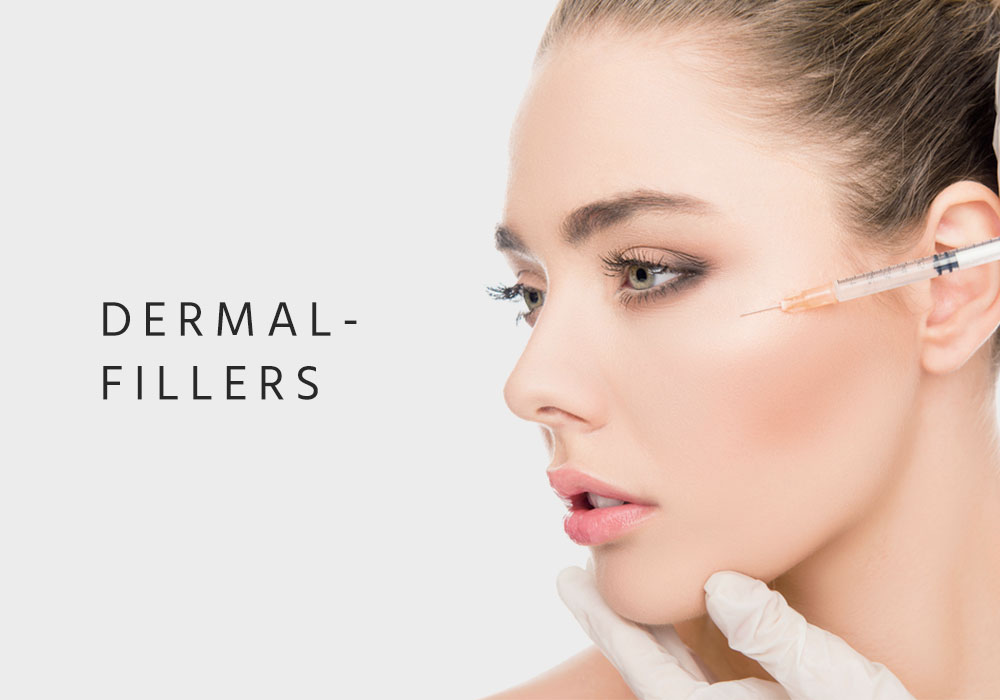Dermal Fillers
Overview
Dermal fillers are injectable treatments used to restore volume, smooth out wrinkles, and enhance facial contours. They are a popular non-surgical option for facial rejuvenation and can provide immediate and noticeable results.
Types of Dermal Fillers
Hyaluronic Acid (HA) Fillers
- How They Work: Hyaluronic acid is a naturally occurring substance in the skin that helps retain moisture and add volume. HA fillers are used to plump up the skin, smooth wrinkles, and enhance facial features.
- Popular Brands: Juvederm, Restylane, Belotero.
- Duration: Results typically last 6 to 18 months, depending on the specific product and treatment area.
Calcium Hydroxylapatite Fillers
- How They Work: Calcium hydroxylapatite is a mineral-like compound found in bones. When used in dermal fillers, it provides structural support and stimulates collagen production.
- Popular Brands: Radiesse.
- Duration: Results can last up to 12 months or longer.
Poly-L-Lactic Acid Fillers
- How They Work: Poly-L-lactic acid stimulates collagen production, gradually improving skin thickness and reducing wrinkles over time.
- Popular Brands: Sculptra.
- Duration: Results develop gradually over a few months and can last up to 2 years.
Polymethylmethacrylate (PMMA) Fillers
- How They Work: PMMA fillers contain tiny beads suspended in a gel, providing long-lasting support and volume.
- Popular Brands: Bellafill.
- Duration: Results are semi-permanent, lasting 5 years or more.
Autologous Fat Injections (Fat Grafting)
- How They Work: Fat is harvested from another part of the patient’s body (usually the abdomen or thighs), purified, and injected into the treatment area.
- Duration: Results can be long-lasting but may require multiple sessions.
Treatment Areas
- Cheeks: To restore volume and contour.
- Lips: To add volume and define shape.
- Nasolabial Folds: To smooth out deep lines running from the nose to the mouth.
- Marionette Lines: To reduce lines running from the corners of the mouth to the chin.
- Under-Eye Hollows: To fill in and smooth out hollows or dark circles.
- Jawline and Chin: To enhance definition and contour.
- Hands: To restore volume and reduce the appearance of veins and tendons.
Procedure
- Consultation: A thorough consultation with a qualified practitioner to discuss goals, assess facial anatomy, and determine the appropriate type and amount of filler.
- Preparation: The treatment area is cleaned, and a topical anesthetic may be applied to minimize discomfort.
- Injection: The filler is injected into the targeted areas using fine needles or cannulas. The practitioner may massage the area to ensure even distribution.
- Post-Treatment Care: Instructions are provided to reduce swelling and bruising, such as applying ice packs and avoiding strenuous activities for a short period.
Benefits
- Non-Surgical: No incisions, anesthesia, or extended recovery time.
- Immediate Results: Most fillers provide instant volume and smoothing effects.
- Customizable: Treatments can be tailored to individual needs and desired outcomes.
- Natural-Looking: When administered by skilled practitioners, results can be subtle and natural-looking.
Risks and Side Effects
- Common Side Effects: Redness, swelling, bruising, tenderness, or itching at the injection site.
- Rare Side Effects: Infection, allergic reactions, lumps or nodules, migration of the filler, and vascular complications (e.g., occlusion of blood vessels).
- Temporary or Permanent: Most fillers are temporary, but some can be longer-lasting or even permanent.
Ideal Candidates
- Individuals looking to enhance facial contours, restore volume, or reduce wrinkles and fine lines.
- Those seeking non-surgical options for facial rejuvenation.
- People with realistic expectations about the results.
Contraindications
- Pregnant or breastfeeding women.
- Individuals with certain autoimmune diseases or allergies to filler ingredients.
- Those with active skin infections or inflammation in the treatment area.
Choosing a Practitioner
- Ensure the practitioner is licensed, qualified, and experienced in administering dermal fillers.
- Schedule a consultation to discuss your medical history, treatment goals, and any potential risks.
- Look for reviews, before-and-after photos, and recommendations from other patients.
Preparation and Aftercare
- Preparation: Avoid alcohol, blood-thinning medications, and certain supplements (e.g., fish oil, vitamin E) a few days before the procedure to reduce the risk of bruising.
- Aftercare: Follow the practitioner’s aftercare instructions, which may include avoiding strenuous activities, excessive sun exposure, and touching or massaging the treated areas for a specified period.
Dermal fillers offer a versatile and effective solution for facial enhancement and rejuvenation. For the best results, consult with a qualified practitioner to determine the most appropriate treatment plan based on your individual needs and goals.




